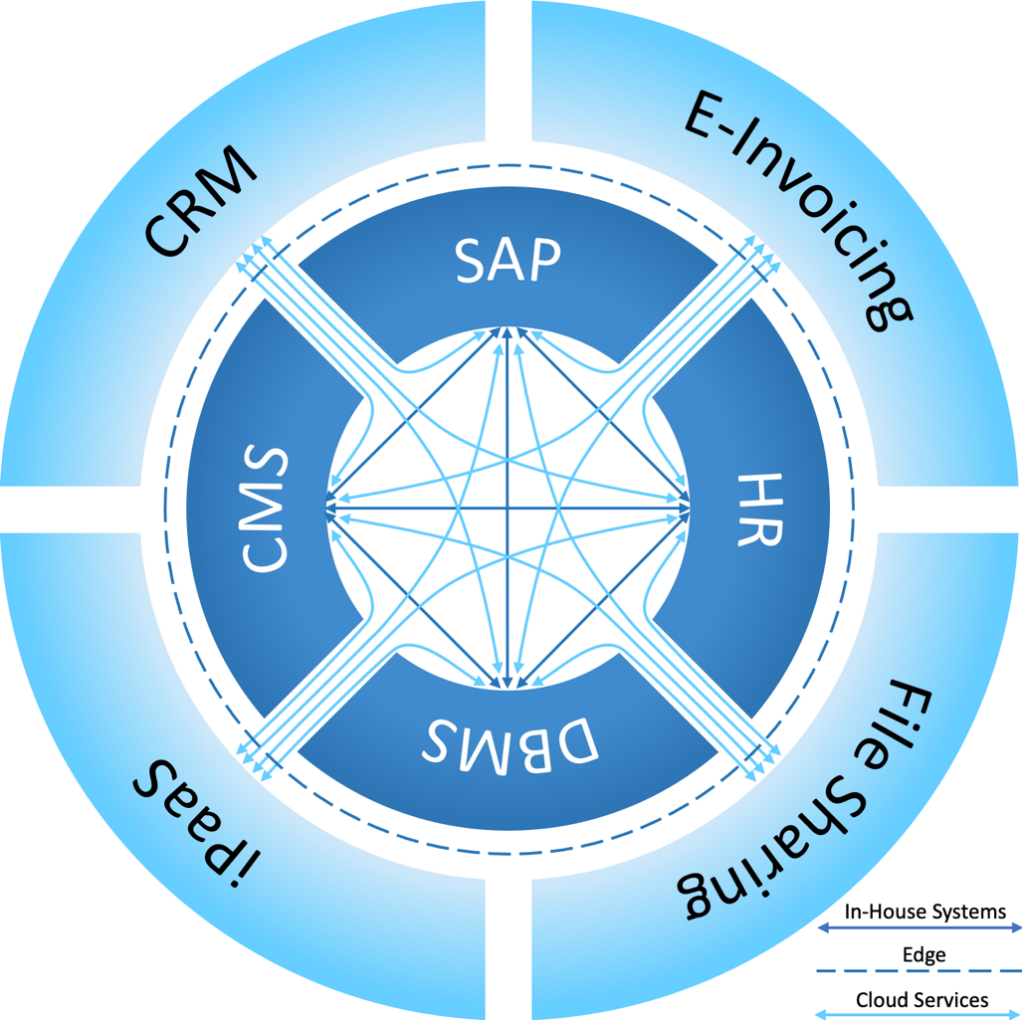- Learn
-
Network
- Featured Event:
- Collaborate
- Influence
- Partners
-

-

Does the biggest question on your mind start with “How in the world of SAP S/4HANA are we going to…?” and end with:
Over the course of ~30 years, SAP customers have aired their integration challenges such as those listed above. It is recognised that ERP systems are the lifeblood of many an IT ecosystem, and that any service disruption can place your reputation at risk. Based upon our experience, here are three key considerations for your S/4HANA integration projects:
1) Think Beyond SAP: consider the entirety of your IT landscape integration requirements, not just those for SAP
2) Think Beyond the Edge: consider external services integration, not just in-house
3) Think Beyond Your SI: consider complimentary capability beyond that which your SI can provide
These considerations are expanded upon below:

|
Figure 1 – Non-HIP Environment |
Think Beyond SAP: Although SAP is most likely the lifeblood of your IT ecosystem, a common mistake is to think of it as being in a bubble. To think like this would wrongly categorise your SAP system as a discrete component in relation to the rest of your IT landscape. It most definitely isn’t - your SAP system is a highly important interconnected component that periphery systems and services rely upon for their own data consumption and publication. The healthiest mindset with which to approach an integration project, is to think of your IT landscape from the outside-in, i.e. from your outer IT systems working your way in to your central SAP system. Using a spider diagram (or a variation thereof as shown in Figure 1) to map the relationships between periphery systems and your central SAP system is a good technique to use. This can also be used to capture important information such as communication protocols used, e.g. tRFC / BAPI, HTTP(s) and data standards usage, e.g. IDocs, SOAP APIs etc. Identifying commonalities in this way maximises your potential to streamline communications, therefore reducing potential points of failure, across the entirety of your IT landscape. Streamlining communications can be achieved by utilising a category of technology that goes beyond what’s included in SAP’s portfolio. It’s what Gartner call a Hybrid Integration Platform (HIP). A HIP acts as a central point of control for data standards compliancy. It can orchestrate data exchanges in the most efficient manner possible between every system across your entire IT landscape, including SAP of course. An example of the way in which a HIP can streamline connections and thus increase the reliability of inter-system communications can be appreciated from Figure 2.

Figure 2 – HIP Orchestrated Environment
2) Think Beyond the Edge: The ‘edge’ is a phrase used to describe the DMZ (firewalls) within an organisation. It’s beyond this edge that we encourage you to extend your focus in terms of external integration requirements. In the ever more services-oriented and cloud-based world that we operate in, be sure to consider third party systems or cloud services that benefit from access to your SAP oriented data. An example of this could be e-invoicing solutions that are provided as cloud-based services. Third party services like these may use more traditional methods of connectivity such as EDI, or increasingly popular API based methods. The point being that when it comes to integrating your IT landscape in its true beyond-the-edge entirety, you need a HIP that can securely, reliably and seamlessly integrate externally hosted third party services.
Think Beyond Your SI: The chances are you have been a client of SAP’s for some time, have built a relationship with an SI for the services work, and feel reasonably comfortable with the modus operandi. Whilst there are many comprehensive offerings in the IT arsenal of both SAP and SIs, offering far-and-wide reaching integration across the entire IT landscape by way of a HIP is not one of them. This is why SAP themselves acknowledge the role that experienced integration specialists have to play when addressing migration and integration challenges. We therefore encourage you to think not only beyond SAP and your edge, but also beyond the capabilities of your SI.
We hope the above three considerations for your S/4HANA integration project resonates somewhat with you, and at least give you some food for thought.
No matter how tough your SAP S/4HANA integration challenges appear to be, the chances are they have previously been encountered and solved elsewhere.
Our latest insights and thoughts